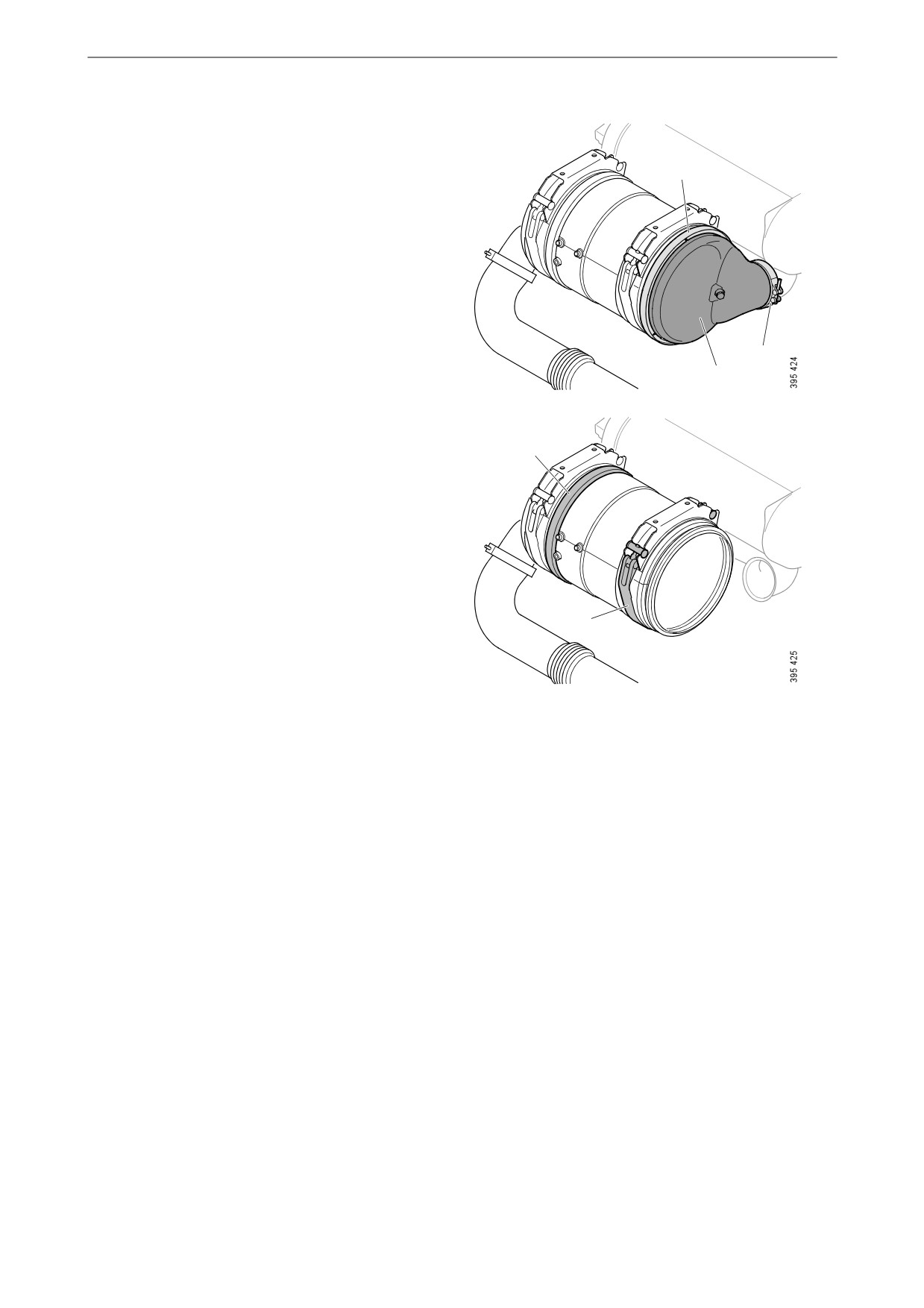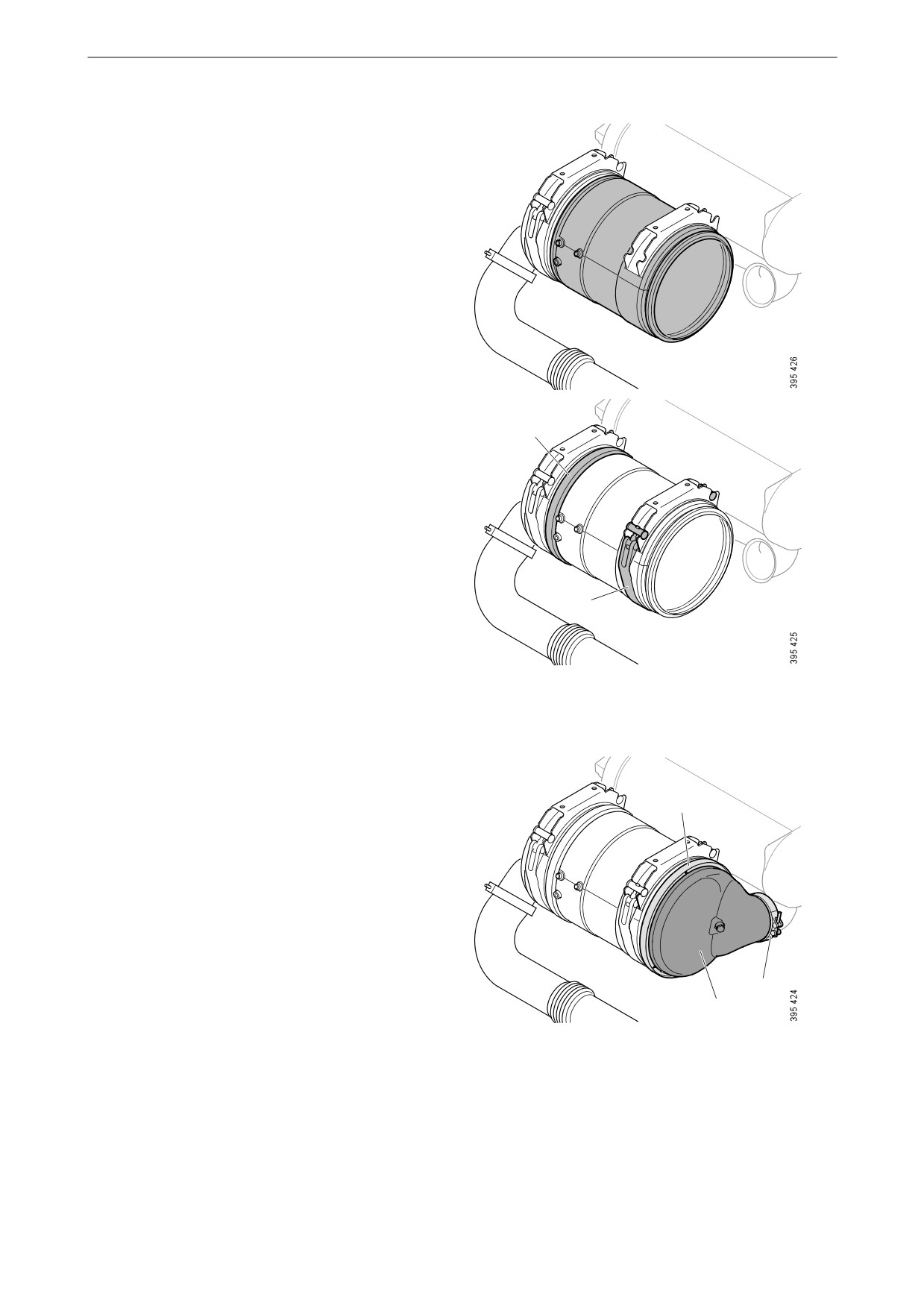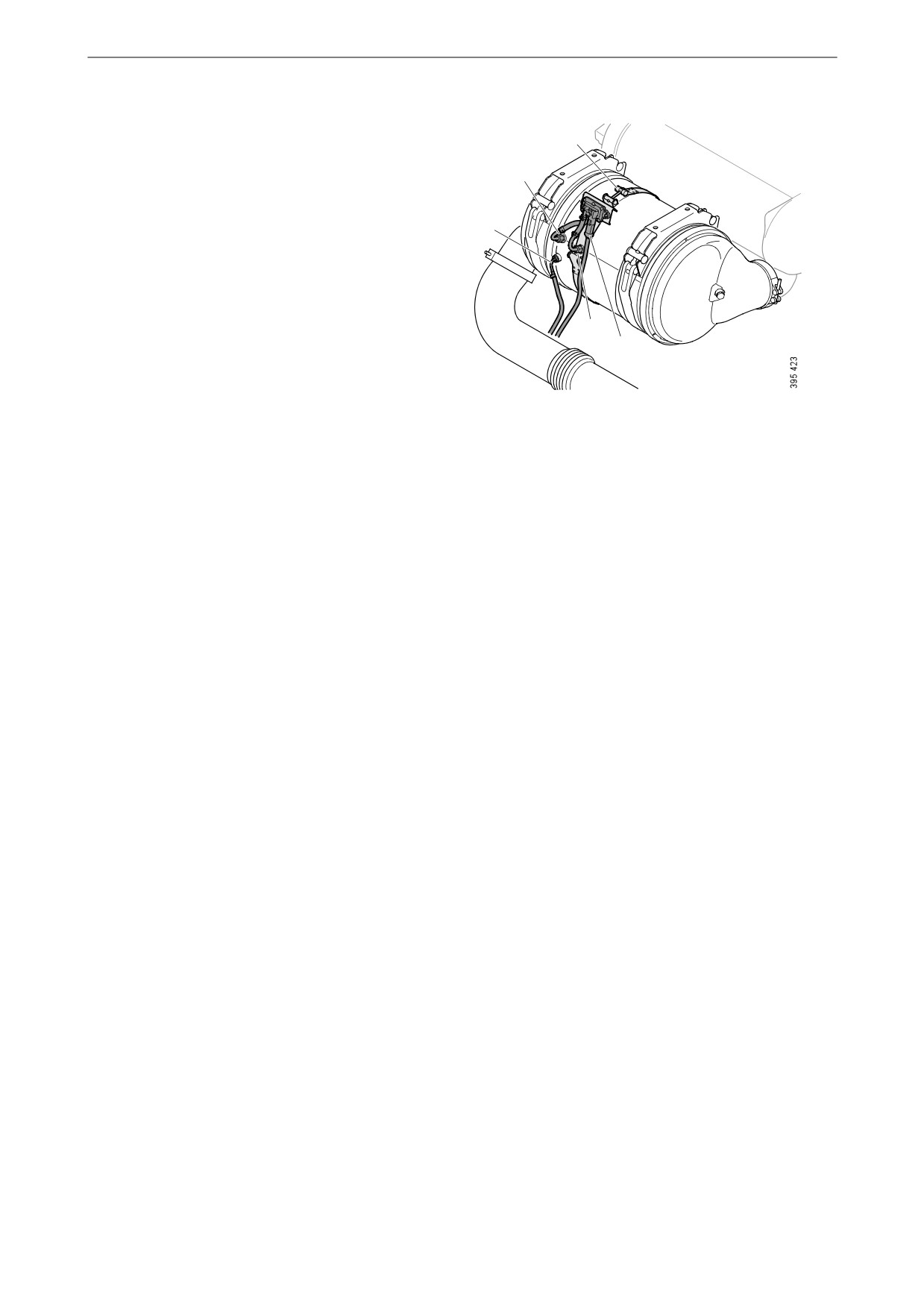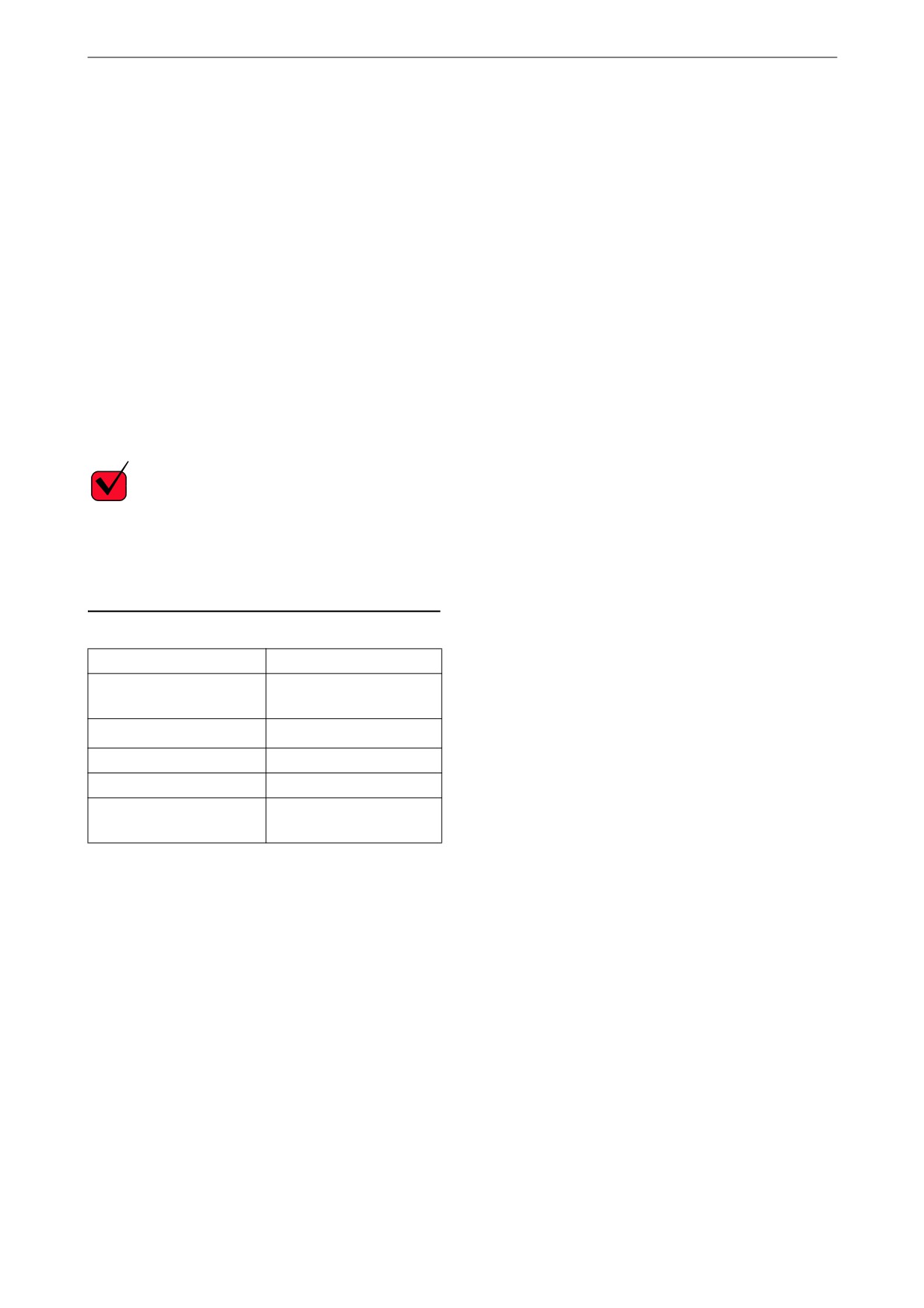Scania DC13 XPI. Industrial engine. Operator’s manual - part 7

Miscellaneous
2.
- Remove the V-clamp at the particulate fil-
ter outlet (1)
2
- Remove the V-clamp securing the end
plate (2) and remove the end plate (3)
1
3
2
3.
- Support the weight of the particulate filter
using a jack.
- Remove the V-clamp (2) and the band
clamp around the particulate filter (1).
1
96

Miscellaneous
4.
- Carefully lift off the old particulate filter.
- Make a note of the serial number of the
new particulate filter.
- Fit the new particulate filter. Use a jack to
support the particulate filter.
2
5.
- Fit the V-clamp (2) and the band clamp
around the particulate filter (1).
1
2
6.
- Fit the end plate (3).
- Fit the V-clamp securing the end plate (2).
- Fit the V-clamp at the particulate filter
outlet (1).
1
3
97

Miscellaneous
7.
- Fit the bracket with the differential pres-
4
sure sensor.
2
- Fit the differential pressure sensor connec-
tions to the particulate filter (2).
– Fit the temperature sensor (1) and connect
1
the differential pressure sensor harness-to-
component connector (3).
2
3
98

Quality requirements for fuel
Quality requirements for
fuel
Quality requirements and testing standards for
the most important properties of different types
of fuel are described in the Workshop Manual.
This can be ordered from Scania dealers or di-
rectly from Scania.
Diesel
Properties
The quality of the diesel is very important for the
operation and service life of the engine and the
fuel system, and also for the engine performance.
REQUIREMENT!
The diesel should comply with the requirements
of European standard EN590.
However, Scania accepts larger tolerances of
certain properties. Please see the table below.
Property
Requirement
Viscosity at 40°C
1.4-4.5 cSt
(104°F)
Density at 15°C (59°F)
0.77-0.87 kg/dm3
Ignitability (CET rating)
minimum 49
Lowest flashpoint
56°C (132°F)
Particulate contamina-
Classification 22/20/17
tion level
according to ISO 4406
99
Quality requirements for fuel
Sulphur content
IMPORTANT!
The operator is responsible for using the correct
type of diesel to ensure that local laws are com-
plied with.
Important to use low sulphur diesel
It is important for sulphur-free or ultra-low sul-
phur diesel to be used on engines with SCR sys-
tems certified in accordance with Stage III B/
Tier 4i or later to ensure that the engine operates
correctly. If diesel with an excessive sulphur
content is used, it can cause damage to the engine
and the SCR system.
From January 2011 legislation in the USA and
Europe requires all diesel engines not used on the
road to be run on sulphur-free or ultra-low sul-
phur diesel.
REQUIREMENT!
In Europe, the diesel should be sulphur-free ac-
cording to standard EN 590. This means that the
sulphur content must not exceed 10 ppm.
In the USA, the diesel must be ultra-low sulphur
in accordance with the ASTM D975 standard.
This means that the sulphur content must not ex-
ceed 15 ppm.
100

Quality requirements for fuel
Permitted sulphur content in diesel
Engine type
Max. sulphur content
Note
Engines without EGR and SCR
4,000 ppm (0.4%)
If the sulphur content is higher than
systems
2,000 ppm, the oil change intervals
must be halved. A higher sulphur
content than 4,000 ppm is not per-
mitted, since this will result in en-
gine damage.
Engines with SCR system only
500 ppm (0.05%)
A higher sulphur content than
10 ppm for Europe or 15 ppm for
the USA may only be used where
Stage III A/Tier 3 or less restrictive
emission laws apply.
Engines with both EGR and SCR
350 ppm (0.035%)
A higher sulphur content than
systems
10 ppm for Europe or 15 ppm for
the USA may only be used where
Stage III A/Tier 3 or less restrictive
emission laws apply.
Diesel with a higher sulphur content than
500 ppm for engines with SCR systems
If diesel with a higher sulphur content than per-
mitted is used on a short-term basis, this will not
cause permanent damage to the SCR catalytic
converter. The SCR catalytic converter may,
however, require diesel with a low sulphur con-
tent for some time after this to regain its normal
efficiency.
If diesel with too high a sulphur content is used
for a prolonged period, there is a risk that the
SCR catalytic converter will not operate correct-
ly, which will result in a reduction in engine
torque.
101
Quality requirements for fuel
Temperature dependence of diesel
IMPORTANT!
Mixing kerosene or other paraffins with the die-
sel is prohibited. The injectors may be damaged.
It is not permissible to mix petrol with diesel. In
the long term petrol can cause wear in the injec-
tors and engine.
At temperatures lower than those specified for
the diesel, paraffin wax may precipitate from the
diesel and block filters and pipes. The engine can
then lose power or stop.
The diesel is adapted for use in the specific cli-
mate of each country. If an engine is to be oper-
ated in a temperature zone with a temperature
lower than normal, first identify the temperature
properties of that particular diesel.
HVO
HVO is a synthetic diesel which is manufactured
through the hydrogenation of plants and animal
fats. To the user, HVO is reminiscent of diesel in
accordance with EN590, apart from HVO having
a somewhat lower density.
Scania approves the use of up to 100% HVO for
all engines in accordance with the European
standard EN 15940.
102
Quality requirements for fuel
Biodiesel (FAME)
Use of biodiesel
IMPORTANT!
For engines with SCR systems, a maximum of
10% mixture of biodiesel should be used.
Scania uses the term biodiesel to refer to a re-
newable diesel made from greases or oils and
methanol. The biodiesel should conform to the
requirements of European standard EN 14214 or
Brazilian standard ANP-45. For biodiesel in ac-
cordance with EN 14214 or ANP-45, the generic
term FAME is frequently used.
Normal diesel in accordance with EN 590 can
contain up to 7% biodiesel from the diesel sup-
plier. There are grades of diesel that comply with
EN 590 but contain a higher mixture of biodies-
el.
Scania approves up to a 10% mixture of biodies-
el for all engines.
103
Quality requirements for fuel
Storage of biodiesel
IMPORTANT!
Biodiesel must not be stored for more than 6
months.
Biodiesel has a maximum storage life of
6 months from the date of production to the ex-
piry date. Biodiesel is affected by light, temper-
ature, water, etc. during storage, which affects
the characteristics and durability of the biodiesel.
Biodiesel also has lower stability against oxida-
tion than diesel. This can result in a thickening of
the biodiesel and blocking of parts of the fuel
system, e.g. the fuel filter. Bacterial growth can
occur when fuel is stored in tanks under unfa-
vourable conditions. Avoid storage in barrels or
auxiliary tanks, except when fuel turnover rates
are high. Check tank cleanliness whenever refu-
elling takes place.
If the engine has been refuelled with biodiesel,
and is stationary for a long period, condensation
water can form in the fuel tank resulting in bac-
terial growth.
See also the section Preservative fuel.
104

Reductant for SCR
Reductant for SCR
IMPORTANT!
The operator is responsible for using the correct
type of reductant to ensure that local laws are
complied with.
REQUIREMENT!
In order for the emission control to meet the
emission requirements set by the public authori-
ties, the reductant should be specified in accord-
ance with ISO 22241.
Reductant is a solution consisting of urea and
water, and is usually called AdBlue®, DEF,
ARLA 32 eller AUS 32, depending on the mar-
ket. If the engine is equipped with an SCR sys-
tem, the reductant is added to the exhaust gases
upstream of the catalytic converter. This reduces
nitrogen oxide emissions.
Reductant in accordance with ISO 22241 con-
tains 32.5% by weight of urea and freezes at ap-
proximately -11°C (12°F). When the solution
freezes, ice and urea always maintain the same
concentration. Always store reductant at a tem-
perature between -11°C and 30°C (12-86°F).
Rec. % by weight of
Limit values according
urea
to ISO 22241
32.5%
31.8-33.2%
105
Reductant for SCR
Reductant is normally colourless if no dye has
been added. It is not harmful to the skin. Nor is it
toxic in small quantities, but it tastes very un-
pleasant.
Reductant is highly corrosive. Therefore, rinse
any reductant spillage from connections and oth-
er details using lukewarm water. Water works
very well for cleaning purposes. Please use hot
water. If reductant seeps into electrical connec-
tions or electrical cables, these must be renewed.
Reductant has a low surface tension and rapidly
spreads over large areas, which then become
very slippery.
Reductant can dry out and form white or greyish
brown crystals or deposits that can be washed
away with warm water.
The risk of crystal formation increases with low
outdoor temperatures. When the outdoor temper-
ature is below -20°C (-4°F), reductant dosing is
switched off to avoid the risk of crystals forming
in the SCR system.
106
Preparing the engine for storage
Preparing the engine for
storage
If the engine is not being used for an extended
period its cooling system, fuel system and com-
bustion chamber and outside must be protected
against rust.
The engine can normally stand idle for up to
6 months without needing preparation. For
longer periods of than 6 months, however, the
measures in the following sections must be tak-
en. These measures provide protection for ap-
proximately 3 years, then the preparing
procedure must be repeated. An alternative to
preparing the engine for long-term storage is to
start the engine and warm it up every 6 months.
Preparation means that the following measures
are taken:
• The engine is cleaned thoroughly.
• Run the engine for a specific period using
special preservative fuel, oil and coolant.
• Otherwise prepare the engine for storage (fil-
ter renewal, lubrication, etc.).
Preservative products
Preservative oil
Use a normal engine oil that meets the require-
ments in the Oil grade section.
Preservative coolant
Use coolant containing 50% by volume of gly-
col. Example: BASF MPG Glysacorr P113 and
Valvoline Zerex P113 FP.
WARNING!
Ethylene glycol can be fatal if ingested and can
cause skin irritation and eye damage.
107
Preparing the engine for storage
Preservative fuel
Preservative fuel must not contain biodiesel.
Even small amounts of 5-10% biodiesel can have
adverse effects on the engine when in long-term
storage.
Long-term storage of diesel, where the diesel
comes into contact with water, may lead to the
growth of micro organisms (bacteria and fun-
gus).
In order to minimise the growth of micro-organ-
isms, preservative fuel should contain the fol-
lowing additives. The additives should be
selected and added by the fuel supplier.
Preservative fuel should comply with the follow-
ing requirements:
•
0% biodiesel.
•
Max. sulphur content 50 ppm.
•
Max. water content 200 ppm.
•
The fuel must contain additives to stop the
growth of micro-organisms.
Reductant
Over time, the water in the reductant evaporates
and there is only urea left. The reductant then be-
gins to crystallise. The reductant tank is not sen-
sitive to crystals, but the ball valves in the
reductant pump may become clogged. However,
note that corrosion or other particles can also
clog the ball valves.
So that the water in the reductant does not evap-
orate, all connections in the SCR system must be
closed before storage. The SCR system should
then be stored in a cool location and not in direct
sunlight. If the reductant tank has never been
filled with reductant, it can be stored when emp-
ty for an unlimited time.
When the engine is taken into operation again,
all reductant must be drained and changed. If old
reductant is used, the SCR system will not work.
108
Preparing the engine for storage
Preparations for storage
Environment
Use a suitable container. Used oil, coolant and
reductant must be disposed of as specified in na-
tional and international laws and regulations.
Note:
Do not remove the injectors.
1. Remove plugs and tape from the coolant
connections, air intake and exhaust pipe.
2. Drain the oil.
3. Renew the oil filter and fuel filter.
4. Clean the centrifugal oil cleaner.
5. Fill with engine oil to the minimum level on
the oil dipstick.
6. Drain and flush the cooling system of any old
coolant.
7. Top up with preservative coolant.
8. Mix preservative fuel in a can. Detach the
fuel pipe at the feed pump suction line and
connect a hose from the can.
109
Preparing the engine for storage
9. Detach the fuel pipe at the overflow valve
and connect a return hose to a separate can.
10. Connect and bleed the fuel system.
11. Start the engine and run it at about 1,100 rpm
for 20 minutes.
If the engine has an SCR system and the re-
ductant tank is empty, it is possible to run the
engine for this limited time without damag-
ing the components of the SCR system. This
applies if the engine is run without load.
12. If the engine has an SCR system and the re-
ductant tank is full of reductant: Seal all con-
nections in the SCR system.
13. Remove the rocker covers and lubricate the
valve mechanisms with pushrods and the
valve tappets, as well as the injector mecha-
nism, using a liberal amount of preservative
oil. Refit the rocker covers.
14. Drain the coolant if the engine is not to be
stored with coolant in the system. Plug and
tape all coolant connections if the engine is
to be stored without coolant in the cooling
system.
15. Renew the filter element in the air cleaner.
16. Cover the air intake and exhaust pipe.
17. Spray the outside of the alternator and starter
motor with water-repellent anti-corrosive
oil: CRC 226, LPS1 or equivalent.
18. Spray the outside of bright engine parts, first
with penetrating preservative oil such as
Dinitrol 25B and then with Dinitrol 112 or
the equivalent.
19. Clearly mark the engine with the storage
preparation date, and state that the engine
must not be started or cranked.
110
Preparing the engine for storage
Batteries
WARNING!
Wear protective gloves and protective goggles
when charging and handling batteries. The bat-
teries contain a highly corrosive acid.
Remove the batteries and trickle charge them at
the battery charging station. This does not apply
to batteries specified as maintenance-free by the
manufacturer.
The same applies to short-term storage, even if
the engine has not been prepared for storage as
above.
Storage
After the preparation, the engine should be
stored indoors in a dry location at room temper-
ature. The engine must be packed in packaging
made of VCI plastic to protect against dust, dirt
and moisture.
111